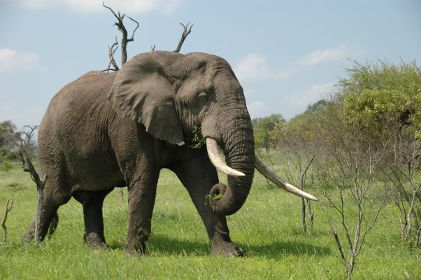Discover the grandeur of Kruger National Park elephants as we share a few simple tips about viewing this remarkable species.
Elephants move with a majesty fitting for the ancient species they are. They’re the largest land animals in the world and a symbol of safaris in Africa.
They’re one of the big 5, traditionally the most sought after hunting trophies (the other four are lions, buffalos, rhinos and leopards). Their ivory tusks were prized.
Today, everyone can enjoy watching an elephant. Kruger National Park is their sanctuary and at the last estimate made in 2011, there were 13,750 of them!
 Elephants are very intelligent and are famous for their excellent memories. They graze in herds ranging from a few to over a hundred in number. If you come across a herd this large crossing the road, be prepared to wait until they’ve all passed before you can drive on. Elephants can be about 6 times bigger than your car. Let them have right of way!
Elephants are very intelligent and are famous for their excellent memories. They graze in herds ranging from a few to over a hundred in number. If you come across a herd this large crossing the road, be prepared to wait until they’ve all passed before you can drive on. Elephants can be about 6 times bigger than your car. Let them have right of way!
| Quick elephant facts | |
| Latin name | Loxodonta africana |
| Famous for | Being the world's largest land mammal |
| Diet | Herbivore, eats up to 200kg (441lb) per day |
| Weight | 5,500-7,500kg (12,125-16,534lb) |
| Shoulder height | 3-4m (9.8-13.1ft) |
| Gestation period | 22 months producing a single calf |
Sometimes when an elephant steps behind a tree it vanishes! How can such a big animal disappear? Very easily. The legs look like tree trunks and the foliage hides the elephant’s body! This also means you may be very close to an elephant without knowing it, plus they barely make a noise when they walk. One may all of a sudden step out onto the road seemingly appearing from nowhere!
 The Magnificent Seven
The Magnificent Seven
The Magnificent Seven are some famous Kruger National Park elephants! They’re celebrated because of the length of their tusks which ranged from 207cm (81″) to 317cm (125″) long. A single tusk this size can weigh as much as an adult!
The Magnificent Seven each have a name. They’re called:
 Dzombo
Dzombo- João
- Kambaku
- Mafunyane
- Ndlulamithi
- Shawu
- Shingwedzi
All of the Magnificent Seven have come to the end of their lives, but the tusks belonging to each of them are on display at the Elephant Hall in Letaba Rest Camp. It’s well worth visiting if you’re in the area. You can touch the tusks and size them up against yourself and read about the lives of each elephant.
Take Care around Elephants
Scared of being stampeded? There’s no need to be. Stampeding is an extremely rare event and avoiding aggressive elephants is easy if you take note of the warning signs. We’ve learnt from experience that elephants may be aggressive if:
- You’re in the their territory
- There are elephant calves nearby
- They’re in a bad mood
So, how can you manage these situations? Read the next section to find out!
Approaching Elephants
If we’re in our car and we spot an elephant close by (within 25m (80ft) of the direction we’re travelling in) we approach slowly. We don’t toot our horn because it can startle an elephant. We take a few moments to watch the elephant’s behaviour.
Is it grazing for food? Is it walking away from us? If it’s grazing or walking away we continue slowly.
Is the elephant walking towards us quickly? Does it look aggressive? Did it make a trumpeting noise? These are danger signs, especially if it is a male elephant. If we see any of these, we drive away from the elephant immediately.
If our car is facing the elephant, we don’t turn it around. We just reverse until we’re in the clear. Luckily for game viewers, most elephant aggression is a warning only. But do heed the warning.
 If we stop to watch elephants with other vehicles nearby, we position our car so that we can drive away promptly. This gives us a clear escape path if an aggressive elephant approaches. We don’t want to be in a traffic jam when we need to get away in a hurry!
If we stop to watch elephants with other vehicles nearby, we position our car so that we can drive away promptly. This gives us a clear escape path if an aggressive elephant approaches. We don’t want to be in a traffic jam when we need to get away in a hurry!
If we come across only female elephants with calves, they’ll generally not be aggressive when they see us. They’ll want to shepherd their calf away from the car instead.
Despite all the care one seems to take around elephants, they really are marvellous creatures to view, their gigantic size making them super special. And, because there are so many Kruger National Park elephants, you can’t miss them, even on a short safari.